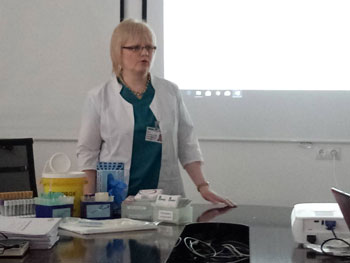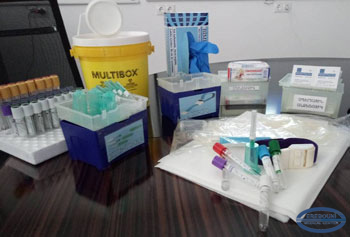Today it is almost impossible to imagine the work of the medical sphere without blood testing.
On 11 April 2018 the next seminar was held in MC Erebouni within the framework of a consistent nurse development programme, designed over 10 years ago, to ensure high quality medical care. It was organized by the Head of Nursing Service of MC Erebouni, doctor-epidemiologist Z.E. Ohanyan,MD , as well as by the lecturer of “Nursing Faculty” of YSMU after M. Heratsi and Armenian-American State Medical College Erebouni, Head of the Comission of Hospital Nursing Education of MC Erebouni Dr. A.A. Kocharyan.
https://www.erebunimed.com/eng/news.more/283
The theme of the event focused on the improving the skills and technique for blood sampling.
Blood sampling is one of the most common invasive manipulations in the provision of medical care. Errors that occur in the process of action plans can lead to changes in data of the taken samples. Ensuring the accuracy of blood sampling is extremely important in order to avoid laboratory errors, to diagnose and prescribe the right treatment, and even to prevent a fatal outcome.
As noted Dr. A. Kocharyan, there is a certain action plan for carrying out necessary manipulations. Blood sampling, mainly from the veins, is performed by a nurse who follows the doctor's instructions, checks food, medications or other factors that may affect the procedure or its results, then inform the doctor. The nurse prepares the necessary materials, conducts hand hygiene, explains to the patient the process of the actions carried out and receives oral agreement from him. Blood sampling is performed in compliance with a special aseptic technique used for invasive interventions; it is important to be carried out from the distal veins of the non-dominant hand, since proximally located and arterial veins may be necessary for further interventions.
 |
 |
||
 |
 |
If for some reason blood sampling from peripheral vein is impossible by puncture method, sampling is carried out either from peripheral or central venous catheter. Saline wash of the catheter and vein lumen is carried out before sampling. Dr. Kocharyan paid a special attention to the necessity of antiseptic wash for the catheter head on every time you use it.
Arterial blood sampling is carried out to assess the gas composition and determine the blood`s acid-base balance. In this aspect, the blood sample is extremely sensitive to the temperature of the environment and to the time.On the factors influencing the blood sample, the nurse notes either on the referral or on the test tube from the specimen taken (delivery of supplemental oxygen, artificial respiration, airway suctioning during the last 20 minutes, changes in patient activity).
Safety of the patient in the process of blood sampling is extremely important. This requires: patient identification, anamnestic data, observance of aseptic and antiseptic rules, accurate specimen labeling, timely transportation. Before arterial blood sampling, Allen`s test is carried out.
During the discussion of the report, attention was also focused on the problem of preventing hematoma developing during venipuncture: it is necessary to apply pressure for 2 minutes, with arterial blood sampling- 5 minutes. In the case of anticoagulants, the pressure time is doubled. Special attention is required for samples of K +, blood coagulation, creatinine, cholesterol, glucose, hormones, etc.
With the help of video material, that was interesting and useful, the audience (senior nurses of different departments of MC Erebouni) were able to get acquainted with innovations in the field of blood sampling manipulations, as well as with new laboratory equipment.
 |
 |


